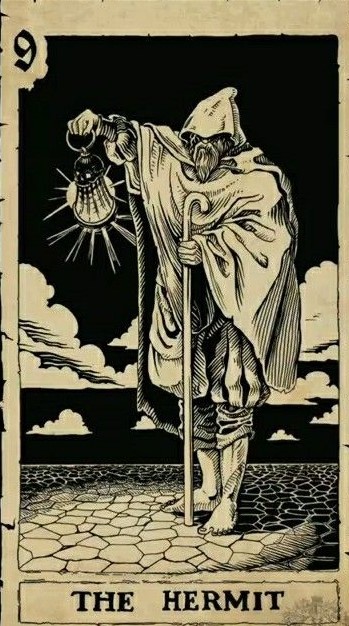|
|
|
|
|
|

|

BOTA (Builders of the Adytum) |

Universal Waite |
1. Solitude; meditation. 2. Introspection; self-analysis; serious, deliberate contemplation before making a major decision. "Holding back" or "reserving judgment." 3. Caution and patience. |

|

|
Note the differences between The Fool and The Hermit. The Fool is about to step off a cliff, and doesn't seem to care; he's looking up, not studying his path, his arms akimbo. The Hermit seems very somber, and he's shining his light down on the path before him, carefully examining it before he takes another step (and he's carefully balancing on his staff). It may be a little while before he makes the next move in his life. |

|

|

|

|

|
|
Here's what Arthur Edward Waite says about this card (in The Pictorial Key to the Tarot):
The variation from the conventional models in this card is only that the lamp is not enveloped partially in the mantle of its bearer, who blends the idea of the Ancient of Days with the Light of the World It is a star which shines in the lantern. I have said that this is a card of attainment, and to extend this conception the figure is seen holding up his beacon on an eminence. Therefore the Hermit is not, as Court de Gebelin explained, a wise man in search of truth and justice; nor is he, as a later explanation proposes, an especial example of experience. His beacon intimates that "where I am, you also may be." It is further a card which is understood quite incorrectly when it is connected with the idea of occult isolation, as the protection of personal magnetism against admixture. This is one of the frivolous renderings which we owe to Eliphas Levi. It has been adopted by the French Order of Martinism and some of us have heard a great deal of the Silent and Unknown Philosophy enveloped by his mantle from the knowledge of the profane. In true Martinism, the significance of the term Philosophe inconnu was of another order. It did not refer to the intended concealment of the Instituted Mysteries, much less of their substitutes, but--like the card itself--to the truth that the Divine Mysteries secure their own protection from those who are unprepared. |